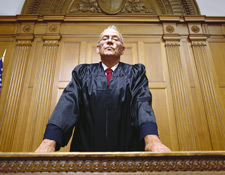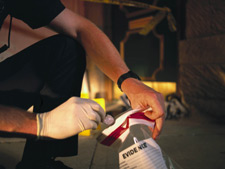Home | Glossary | Resources | Help | Contact Us | Course Map
Archival Notice
This is an archive page that is no longer being updated. It may contain outdated information and links may no longer function as originally intended.
Courtroom Personnel
The courtroom can be an intimidating place. The prosecutor or defense attorney should be able to help the examiner in this area. Being familiar with who's who in the courtroom and their functions can ease apprehension. Court proceedings are normally staffed with the following:
- Judge (or Magistrate depending on jurisdiction).
Presides over the trial/hearing and holds ultimate authority over the proceedings that take place.
- Court Deputy or Bailiff.
Provides security in the courtroom. Bailiffs ensure order in the courtroom, announce the judges entry into the courtroom, call witnesses, and prevent the escape of the accused. Additionally, this individual supervises the jury when it is sequestered and controls public and media access to the jury.
- Court Clerk.
The court clerk provides administrative aid to the court during all proceedings and is normally responsible for handling and securing any evidence that is presented during the proceedings.
- Court Reporter.
Also called a court stenographer or court recorder, the court reporters function is to create a record of all that occurs during trial. This includes verbal comments made in the courtroom, testimony, objections, rulings of the judge, the judges instructions to the jury, arguments made by the attorneys, etc.
The following are self-explanatory:
- Prosecutor (also known as State Attorney, District Attorney, or Solicitor General)
- Defense Counsel
- Defendant
- Jury
The size of the jury will depend on a number of factors. Without addressing alternate jurors, there are three general jury size compositions: none, six, or twelve.
When there are no jurors (in the trial phase) the Judge acts as the jury. This is also referred to as a bench trial.
States can determine the size of criminal trial juries. Most states use juries composed of twelve persons and usually one or two alternates. Some states allow for juries fewer than twelve, but generally no fewer than six.
Legal Issues
Discovery is the process where the prosecuting attorney provides defense counsel with an opportunity to view, copy, or test the evidence in the governments possession. The discovery process is governed by state statutes, rules of procedure, and case law. The discovery process pertains to specific materials in the possession of the experts. The process is not automatic, and the scope of disclosure of discovery materials varies from state to state and court to court. The discovery process is not unilateral and imposes responsibilities upon the defense to disclose certain information to the prosecution.
Evidence and Admissibility
In general, admissibility is the legal concept that determines what evidence, both testimonial and physical, will be admitted by the court and the jury will be permitted to hear. Admissibility is determined by statute, rules of evidence, and case law. This aspect of admissibility relates solely to the admissibility of the science or subject matter at issue and not to the qualifications of the individual.
With respect to scientific evidence, three distinct tests or standards have evolved. They have become known by the case names from which they originated. The Frye test originally involved testing from a polygraph type of instrument. The Frye test was also referred to as the general acceptance standard since it required the methods and techniques to be generally acceptable within the relevant scientific community.
Subsequent to the Frye test was a case that resulted in a new standard being established by the courts. Daubert shifted the determining factor of admissibility away from the general acceptance of the relevant scientific community to the gatekeeper concept. Under Daubert the presiding judge would act as the gatekeeper and determine whether or not the proposed evidence was relevant, applicable to the case, and would be helpful to the jury.
Other hybrid states have either adopted legislation or rules of evidence that modify or alter in some way either the Frye or Daubert standards. The number of states that uses either the Frye or the Daubert standard fluctuates over time.
Additional Online Courses
- What Every First Responding Officer Should Know About DNA Evidence
- Collecting DNA Evidence at Property Crime Scenes
- DNA – A Prosecutor’s Practice Notebook
- Crime Scene and DNA Basics
- Laboratory Safety Programs
- DNA Amplification
- Population Genetics and Statistics
- Non-STR DNA Markers: SNPs, Y-STRs, LCN and mtDNA
- Firearms Examiner Training
- Forensic DNA Education for Law Enforcement Decisionmakers
- What Every Investigator and Evidence Technician Should Know About DNA Evidence
- Principles of Forensic DNA for Officers of the Court
- Law 101: Legal Guide for the Forensic Expert
- Laboratory Orientation and Testing of Body Fluids and Tissues
- DNA Extraction and Quantitation
- STR Data Analysis and Interpretation
- Communication Skills, Report Writing, and Courtroom Testimony
- Español for Law Enforcement
- Amplified DNA Product Separation for Forensic Analysts



